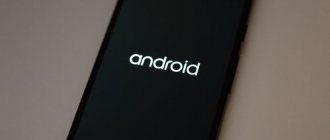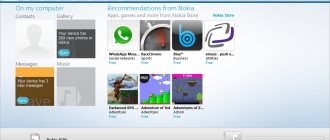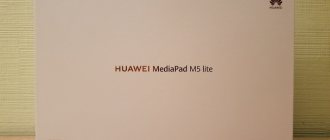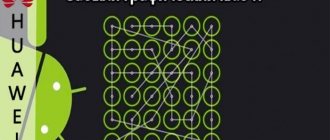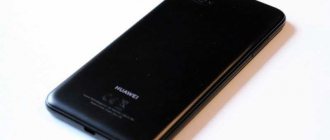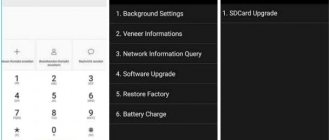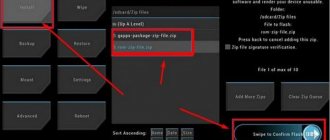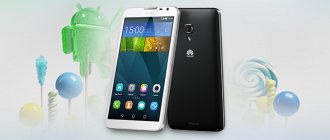Specifications
| operating system | Android 4.1 |
| Screen | 10.1, TFT IPS, 1920×1200 pixels, capacitive, multi-touch, glossy, 224 ppi, Gorilla Glass |
| CPU | HiSilicon K3V2 1200 (or 1400) MHz, 4 cores |
| GPU | Vivante GC4000x2 |
| RAM | 1/2 GB |
| Flash memory | 8/16/32/64 GB |
| Memory card support | microSDHC (up to 32 GB) |
| Connectors | proprietary 30-pin connector for connecting a docking station, SIM card, 3.5 mm headphone jack |
| Camera | rear (8 MP) and front (1.3 MP) |
| Communication | Wi-Fi 802.11n, Bluetooth 3.0 HS, 3G, GPS, GLONASS |
| Battery | 6600 mAh |
| Additionally | accelerometer, compass, light sensor, gyroscope, keyboard dock connection |
| Dimensions | 258x176x9 mm |
| Weight | 580 g |
| Price | $180 |
Huawei MediaPad 10 FHD
In fact, Habr readers correctly downvoted my previous post about the very good smartphone zte v970, and not because I wrote something incorrectly, but because I wanted to write about something completely different: in general, about the phenomenon of Chinese manufacturers, not those that are accepted to lump together the common noun brand “no-name”, and those that are more or less recognizable to the Russian consumer. There are essentially two such manufacturers: ZTE and Huawei. Forgive me, but I don’t consider Lenovo a Chinese company; it is as Chinese as Nokia is Finnish, or Microsoft is American.
A week ago, Huawei held a press breakfast at the Pushkin cafe, at which it presented two new tablets going on sale. These are 7 and 10 inch models, each of which is interesting in its own way. MediaPad 7 Lite is a budget modification of the MediaPad, which has become popular due to its very good characteristics and affordable price. Lite - because the new model is based not on a dual-core, but on a single-core Cortex A8 processor with a frequency of 1.2Ghz.
But I was more interested in another model: MediaPad 10 FHD. From the name you can see that this is a 10-inch tablet with Full HD display resolution. However, not all so simple. Firstly, even with regard to the display resolution, it is not standard Full HD, but 1920x1200. At the same time, this is an IPS matrix with excellent viewing angles, tending to 180 degrees. Secondly, the tablet runs on Huawei’s own 4-core processor combined with a 16-core GPU. This platform was presented earlier this year at the Mobile World Congress in Barcelona and caused a lot of noise, since in tests it turned out to be more powerful than NVIDIA Tegra 3. And thirdly, this is one of the few tablets so far equipped with 2 GB of RAM, although in the sample, When I tested it, the benchmarks showed only 1 GB of RAM.
I used the tablet for several days and despite the fact that I liked it from the very beginning, I could not develop the personal love for it that, for example, I felt for the Nexus 7. It would seem that what else could be needed: a magnificent display, powerful The hardware, although according to benchmarks is inferior in performance to both Tegra 3 and Samsung's Exynos 4412, is sufficient for the device to work without brakes. Three-dimensional games with detailed graphics run no slower on the Cortex-A9 Quad 1.4GHz than on Tegra 3, for example. The 8 megapixel main camera acceptably takes photographs and shoots video in Full HD resolution, and the 1.3 megapixel front camera takes 720p. There is a slot for a full-size SIM card and for micro-SD. The battery capacity of 6600 mAh is easily enough for a long working day, smoothly flowing into the night. And with all this, the tablet weighs only 580 grams. Yes, Apple never removed such a piece of hardware; the new iPad is smaller and weighs almost 100 grams. more!
From an ergonomic point of view, you can only find fault with the protrusion of the main camera eye - I think that over time, because of this protrusion, the lens glass will be scratched, which, of course, is not good. Otherwise, everything is excellent: the aluminum body is only 8.8 mm thick, even the longitudinal white plastic pad on the back cover in the camera area does not spoil the overall appearance. And yet, something is not right, something is not enough, everything seems cool, but the wow effect does not work, although the technical characteristics are frankly top-notch.
It would seem that everything can be blamed on Android ICS (an update to Jelly Bean is promised only in the first quarter of next year), the customization of which is a cross between Samsung's TouchWiz and Meizu's Flyme OS, in which there is no panel of installed applications and shortcuts are placed directly to desktops, just like in iOS. But on the other hand, he is, as they say, ICS, and in Africa ICS, and therefore why find fault with him?
In general, I thought about it for several days and wrote down literally the following in my notebook:
The problem, perhaps, is that neither Huawei nor ZTE have ever had experience developing a user interface, which, by the way, is no less a significant element of the ergonomics of a device than the thickness or material of the back cover. As a result, when it comes to the user interface, these companies offer either the so-called “naked Android” or combinations of certain inventions from other manufacturers. Here, by the way, it would not be amiss to take into account that Samsung’s TouchWiz is far from being an ideally convenient shell. Yes, it can be more or less customized using various delivery programs (keyboard, for example), but still it is far from the ergonomics of iOS or MeeGo Harmattan.
As a result, devices from Huawei and ZTE are no worse than those from Samsung or HTC, and in some technical characteristics they are even better, but since there is no unique offer in terms of user interface, there is no individual recognition, and also because the brands are less promoted than Same as Samsung, Huawei and ZTE have no choice but to dump on price, with all other product characteristics being equal. This, of course, also brings profit, but I think the Huawei and ZTE device division is not yet very profitable, if not subsidized at all.
In connection with all this, I am extremely interested in the statement recently made by Huawei representatives that they say the company is planning to develop its own mobile operating system. True, at a press breakfast in the Pushkin cafe, the Marketing Director of the regional representative office of Huawei Device for Russia and the CIS countries could not comment on this statement, saying that Android, Windows 8 and Windows Phone 8 are priority software platforms for Huawei , and we can talk about our new operating system only if things go badly for the above-mentioned software platforms. In a word, we shouldn’t expect any operating system from Huawei, at least in the near future.
By the way, since we’re talking about Windows 8, it wouldn’t be a bad idea to mention that the Huawei MediaPad 10 FHD tablet also has a keyboard docking station, which was demonstrated at the press breakfast, but it’s not yet available for testing, and even It will go on sale a little later. In a word, the MediaPad 10 FHD is actually not just a tablet, but rather a transformer, reminiscent of Asus’ developments in the field of tablet-netbook form factor.
Anyway, speaking of the user interface, this is what I'm getting at. Recently, a young Finnish startup Jolla Mobile, consisting of former Nokia employees involved in the Maemo&MeeGo project, announced that with the help of the Hong Kong IT cluster Cyberport was able to attract 200 million investments to develop a new mobile operating system based on MeeGo, Silfish. It is noteworthy that it was the Chinese side that became interested in a promising startup whose employees have several very, very thorough, and in some circles even iconic, devices.
However, Jolla employees have experience creating the software part of mobile devices, the experience, without exaggeration, is wonderful, but as for the hardware part, the employees who were involved in this side of developing devices on Maemo&MeeGo remained to work at Nokia.
At the same time, Huawei and ZTE are doing well with the hardware, but not so much with the user interface. So their ability to assemble devices could be very productively combined with the ability of Jolla employees to create unique interface shells for devices. It’s also worth remembering that Jolla has already announced that their new operating system will support applications from the Play Market for Android. In a word, I am sure that all these components can result in a very interesting and relevant product for the market.
And I would like to say one more thing in connection with all this. Personally, I profess the concept: one device - one software platform. Therefore, I would like manufacturers, when creating this or that device, not just to string Android or Win8 onto it, but to create complete, unified devices. So the Win8 interface is literally giving birth to new devices right before our eyes. Ideally, I would like it to be the same for all other devices. But, apparently, this is an unattainable dream, since the market needs speed, not ideal and ergonomic devices. That is why Android is so popular, contributing to the extensive development of the market. That’s why, I’m sure, the same fate awaits Win8 and WP8.
Contents of delivery
The kit includes a charger, a cable for connecting to a computer, and it comes in the form of an adapter from USB to a proprietary 30-pin connector, as well as accompanying documentation, including instructions and a warranty card.
Design
The tablet is practically no different in appearance from others. Most of the front panel is occupied by a touch screen with protective glass Corning Gorilla Glass. The camera lens is visible on the top rim in the middle. There are no physical buttons.
The back panel is made of aluminum. In the middle there is the inscription Huawei, and at the bottom there are logos of Google and various certificates. At the top there are two stereo speakers. At the top in the middle is a camera with flash.
If you take the tablet with the screen facing you, the on/off and screen lock button, as well as the volume rocker, will be located on the left. On the right you will see a headphone jack. There are 3 sockets at the bottom: two on the sides for connecting a docking station, and one in the middle for charging and additional accessories.
On the top edge there are connectors for connecting a SIM card and a flash drive. To gain access to them, you need to pry off the plug with something sharp. The build quality is at an excellent level, nothing creaks or bends. Still, the body is aluminum, which is a big plus. Thanks to this, it was also possible to achieve a small thickness. Holding the tablet in your hands is very comfortable; it does not slip or fall out.
Detailed technical specifications
Brand and model of the device, as well as alternative names (if any). Appearance of the device including dimensions, weight, volume, colors and materials. System on a chip, single-chip system (System on a Chip, SoC) is when several systems performing different device functions.
| Central processing unit (CPU) The main component of the device is responsible for calculations and data processing. | ARM Cortex-A53 |
| Technical process What technological process is used to make the chip? The smaller the process technology, the better - the chips consume less power and generate less heat. | 28 nm (nanometers) |
| Processor size Processor capacity is a parameter that indicates how many bits of data a processor register processes in 1 clock cycle. This is usually 32 or 64 bits. | 64 bit |
| Instruction Set Architecture Instruction set architecture (ISA) is a programmable part of the microprocessor core used by software to control the operation of the processor. | ARMv8 |
| Number of processor cores The processor can be either single-core or multi-core. The performance of the processor depends on the number of cores (threads). The more cores working simultaneously, the higher the power consumption, so in mobile devices all cores are used only under high load. | 4 |
| CPU clock speed Clock speed is the number of operations per second that a processor or its core can achieve. The higher the frequency, the higher the overall performance of the device, but performance also depends on the processor architecture and the number of cores. | 1400 MHz (megahertz) |
| Amount of random access memory (RAM) RAM (Random Access Memory, RAM, RAM) is temporary memory (works only while the device is running), which stores data and code for the operational operation of programs and applications. The more RAM, the more programs you can run simultaneously without loss of performance (there will be fewer “brakes”). | 2 GB (gigabytes) 3 GB (gigabytes) |
| Type of random access memory (RAM) Information about the type of RAM used by the device. | LPDDR3 |
| Number of RAM channels 1 is a single-channel RAM operating mode, basic, when 1 memory module is used. 2 is already a two-channel mode - a mode of parallel operation of 2 modules or pairs of modules, memory channels - this mode is 2 times faster than a single-channel one. 3 – three-channel mode is 3 times faster than single-channel mode. | Single channel |
| RAM frequency The frequency of RAM determines the speed of RAM, or rather the speed of data transfer and reception. In theory, the higher the frequency, the more powerful the RAM. | 667 MHz (megahertz) |
Most mobile devices have built-in Flash memory, which is used as a storage for system data, the operating system, as well as user data - photos, videos, recordings and much more. A mobile operating system (OS) is pre-installed software with a well-thought-out interface for user management functions of the device. To operate autonomously, a mobile device requires a battery that powers all its components.
| Battery capacity The main characteristic of a battery is its maximum capacity, that is, the charge it can store. Capacity is measured in mAh (mAh, milliamp-hour). The higher the capacity, the longer the mobile device can work. | 4800 mAh (milliamp-hours) |
| Battery type Many types of batteries have been used in portable devices, but NiCd (nickel-cadmium), NiMH (nickel-metal hydride), and even more so SLA (lead-acid) batteries are already considered obsolete. Instead, modern mobile devices use Li-Ion (lithium-ion) and Li-Pol, Li-Poly (lithium-polymer) batteries. | Li-polymer |
| Power adapter Characteristics of the charger (adapter, power supply) included in the standard package of the mobile device. More precisely, the output voltage in volts (V) and the output current in amperes (A). | 5 V (volts) / 1 A (amps) |
The screen (display) is the main element for displaying graphic information.
| Technology The technology used to make the screen. There are many types of display manufacturing with their pros and cons. | IPS |
| Diagonal The screen diagonal of a device is measured in inches (inch, in or simply ″), and 1″ is equal to 2.54 cm. | 9.6 in (inches) 243.84 mm (millimeters) 24.38 cm (centimeters) |
| Width Approximate screen width | 206.78 mm (millimeters) 20.68 cm (centimeters) |
| Height Approximate screen height | 129.23 mm (millimeters) 12.92 cm (centimeters) |
| Aspect Ratio Aspect ratio is the ratio of the shorter side of the screen, which is considered to be 1, to the longer side, which is denoted by a decimal fraction indicating the ratio to the short side. | 1.6:1 16:10 |
| Screen resolution Screen resolution is the number of horizontal pixels (dots) multiplied by the number of vertical pixels. The higher the resolution, the more detailed the image will be. | 1280 x 800 pixels |
| Pixel Density The number of pixels per inch or PPI (pixels per inch) indicates the density of pixels per 1 inch (2.54 cm) of the screen. The higher the PPI, the sharper the image, and the less visible or even invisible “squares and dots” (pixels). | 157 ppi (pixels per inch) 61 ppcm (pixels per centimeter) |
| Color depth Color depth means how many bits are used in 1 pixel to display color (bits per pixel). | 24 bit 16777216 colors |
| Screen area Approximate usable area occupied by the screen on the front of the device. The higher the percentage, the narrower the frames around the display or the smaller the “chin with bangs.” | 73.01% (percent) |
| Touch screen A touch screen is a device that usually covers the display and is a touch input tool. In fact, in mobile devices, the touchscreen is a replacement for the keyboard and mouse. | Yes |
| Touch screen type There are many types of touch screens, with their pros and cons. Mobile devices often use capacitive touchscreens, but technology does not stand still and new types of sensors are appearing. | Capacitive |
| Multi-touch Touch screen support for two or more touches. For example, zooming photos with two fingers. | Yes |
| Display Contrast Ratio Contrast ratio is the ratio of display brightness in the white area to the black area. For example, 1000:1 means that white is 1000 times brighter than black. The higher the ratio, the deeper the blacks and the overall better image. | 800:1 |
| Brightness Screen brightness is measured in candelas per square meter (cd/m2, cd/m2). The higher this indicator, the brighter the screen luminosity will be and the less it will be affected by ambient lighting. Comfortable brightness for videos and games is considered to be 300 cd/m2 or more. | 300 cd/m² |
The main camera, usually built into the rear of the device, is designed for creating photo and video content.
| Maximum image resolution This is the maximum number of pixels (dots) horizontally and vertically. The higher the resolution, the more detailed the image will be. Resolution can also be indicated in megapixels - this is the total number of pixels that can be in the image, calculated by the formula: vertical pixels multiplied by the number of horizontal pixels and divide the resulting amount by 1 million. | 2592 x 1944 pixels 5.04 MP (megapixels) |
| Matrix type There are two main types of photomatrix, CCD (Charge-Coupled Device) and CMOS (Complimentary Metal-Oxide Semiconductor). Mobile devices mainly use a CMOS matrix - it requires less space, has low power consumption and heating. Recently, new types of sensors have begun to appear, for example PureCel from OmniVision. | CMOS (complementary metal-oxide semiconductor) |
| Diaphragm Aperture (f-number, f) is used to control the light flux passing through the lens. The aperture is indicated by a fraction, and the smaller the fractional number, the higher the aperture passing through the lens. The more light that passes through the lens, the better overall, less noise in your photos and better night photography. | f/2 |
| Maximum video resolution This is the maximum number of pixels (dots) horizontally and vertically. The higher the resolution, the more detailed the image will be. | 1920 x 1080 pixels 2.07 MP (megapixels) |
| FPS video recording at maximum resolution FPS (Frames per Second, frame rate) is the number of frames that changes in 1 second. The higher the number of frames per second, the smoother the image will be. In this case, we mean the number of frames that the camera can achieve at its maximum resolution; the lower the resolution, the higher the FPS can be. | 30 fps (frames per second) |
| Presence of flash Incorporating a flash into a mobile device allows you to take pictures in low light conditions. Creates the necessary lighting and compensates for the lack of natural light. | Yes |
| Digital zoom With digital zoom (zoom, enlargement), the subject is brought closer due to software image algorithms. The higher the magnification with digital zoom, the worse the image quality (noise, blur) will be compared to a non-zoomed one. | Yes |
| Focus on face Function of auto-detection of living objects and autofocus on their face or head. | Yes |
| Panoramic shooting mode Panoramic photography is a series of frames where each subsequent frame is a continuation of the previous one; at the end of the shooting, all frames are stitched together at the software level to create a panoramic photograph. Frames can be shot both vertically and horizontally, and their width can be up to 360 degrees. This type of shooting is used when the camera's viewing angle is not enough to capture the entire scene. | Yes |
| HDR shooting mode HDR photography takes a quick series of shots with highlights, midtones, and shadows, then combines them into a single frame with high dynamic range. | Yes |
| White balance White balance is a setting that helps ensure the correct color reproduction in an image by determining the color temperature of the light source in the frame. The balance can be set either automatically or manually. | Yes |
| ISO Setting ISO is the level of light sensitivity. The lower the ISO, the less sensitive the camera's light sensor and the smoother the image with less noise. The higher the ISO, the higher the light sensitivity, but more noise, graininess, or decreased sharpness. | Yes |
| Additional Information Additional information about the functions and characteristics of cameras. | Autofocus Continuous shooting Geo-tagging Touch focus Exposure compensation Self-timer Scene select mode |
Front camera of a mobile device (selfie camera, rear camera) - a camera on the front part, which is usually used for video communication, recognition of gestures or faces, selfie photos. Memory card (flash card) - an external data storage device that is used in many devices to increase memory capacity. Subscriber Identification Module (SIM) used in mobile devices to identify a subscriber in cellular networks. This is a system in which communication and data transfer is carried out between subscribers, the location of one or more of which changes.
This section indicates the supported standards and frequencies of mobile communications. Which data transmission standards in cellular networks are supported by the device, as well as their speed. Wi-Fi (Wireless Fidelity) is a technology for wireless data transmission over a local network among devices based on IEEE 802.11 standards. Bluetooth (BT, bluetooth (z), “blue tooth”) is a short-range wireless network (up to 10, sometimes 100 meters) operating on radio waves to transmit voice and data between devices.
| Bluetooth version Bluetooth technology is actively developing and, since 1998, has been constantly updating versions of the standard. Each subsequent version introduces one or several improvements in data exchange speed, range, facilitates pairing, reduces power consumption, or introduces some new protocols and operating profiles. The higher the Bluetooth version, the better. The technology is also backward compatible, for example, if your mobile device has version 5.0, then it will work with accessories version 4.2 and lower, but the improvements introduced in version 5.0 will not work; they will work only if both the device and accessories are version 5. | 4.1 |
| A2DP profile The A2DP Bluetooth profile is designed to transmit a high-quality two-channel stereo signal via Bluetooth to wireless headphones, speakers and other acoustics. | Yes |
Modern devices have many sensors that help in measurements, trigger functions, and make using the device more pleasant. Audio - characteristics and capabilities of a mobile device in terms of sound. The location is determined by satellite navigation systems that track the device's autonomous geospatial location at multiple points. The most common satellite navigation systems are GPS, GLONASS, and the Chinese BeiDou.
| GPS GPS (Global Positioning System) is a global satellite navigation system that can determine the position of a mobile device, build routes and find the desired object on the map with an accuracy of several meters. | Yes |
| A-GPS A-GPS (Assisted GPS) is an assistive technology that will help you quickly find the location of your cellular device without waiting for satellite data, which is especially important in indoors and cities. Location is determined in various ways, for example, Wi-Fi access points, mobile towers, bluetooth and others. | Yes |
| GLONASS GLONASS is a Russian Global Navigation Satellite System, which is similar to GPS and works in tandem with it, increasing the accuracy and speed of navigation. | Yes |
| Additional navigation systems | BeiDou |
USB (Universal Serial Bus) is a serial interface for connecting peripherals to computers, smartphones, laptops and much more. The interface allows you to exchange data and power a peripheral device with energy, as well as connect several peripheral devices to one USB connector at once. A TRS headphone jack (or jack) is a common standard of connectors used for transmitting audio signals.
By diameter there are jack (6.5 mm), mini-jack (3.5 mm) and micro-jack (2.5 mm). In mobile devices, the 3.5mm jack was considered the most popular and widespread, but recently they began to be removed, leaving only USB connectors, through which headphones are connected with a corresponding plug or using adapters. Options for synchronizing a mobile device and connecting it to other devices. A browser is a browser program for viewing sites and their content on the Internet.
Through a browser, you can open websites, search for information, download necessary files, watch streaming videos, play browser games, etc. Mobile devices support many audio file formats, as well as codecs for playing them.
| Default formats The formats that the mobile device supports out of the box are indicated. But if the device does not support the format you need, then you can try adding support for it. Sometimes support depends on the technical characteristics of the device (“hardware”) and nothing can be added here, but often the ability to process a particular audio format depends on the software part. You can install another audio player or codec set separately. | AAC (Advanced Audio Coding) AMR / AMR-NB / GSM-AMR (Adaptive Multi-Rate, .amr, .3ga) eAAC / aacPlus v2 / HE-AAC v2 FLAC (Free Lossless Audio Codec, .flac) M4A (MPEG- 4 Audio, .m4a) MIDI MP3 (MPEG-2 Audio Layer II, .mp3) OGG (.ogg, .ogv, .oga, .ogx, .spx, .opus) WMA (Windows Media Audio, .wma) WAV ( Waveform Audio File Format, .wav, .wave) |
Video file formats that the device supports and is capable of decoding and playing.
| Default formats Video file formats that the device is capable of playing with standard firmware and a standard (built-in) set of programs. Not all formats are supported by default, but you can install a third-party video player and/or set of codecs. | 3GPP (3rd Generation Partnership Project, .3gp) AVI (Audio Video Interleaved, .avi) H.263 H.264 / MPEG-4 Part 10 / AVC video MKV (Matroska Multimedia Container, .mkv .mk3d .mka .mks) MP4 (MPEG-4 Part 14, .mp4, .m4a, .m4p, .m4b, .m4r, .m4v) WebM WMV (Windows Media Video, .wmv) Xvid |
Screen
One of the biggest strengths of the Huawei MediaPad 10 FHD is its display. It has a Full HD resolution of 1920×1200 pixels, a pixel density of 224 ppi, a contrast ratio of 1000:1 and a maximum brightness level of 310 cd/m2. It is protected from scratches and damage by Corning Gorilla Glass, and from smudges and fingerprints by an oleophobic coating. The picture looks great, the colors are reproduced quite accurately, and there is no graininess. The tablet can also be used outdoors; there is enough brightness for this, but, unfortunately, the lack of an anti-glare filter forces you to look for shade in bright sunshine. Adjusting the backlight level allows you to use the tablet even in pitch darkness. Viewing without color distortion is possible at an angle of 178 degrees. The sensor recognizes 10 simultaneous touches and responds to them almost instantly. In a word, the screen leaves a very pleasant impression.
Performance
The tablet has a quad-core HiSilicon K3V2 processor with an operating frequency of 1.2 or 1.4 gigahertz. RAM 1 or 2 gigabytes. The device has a proprietary chipset. Due to the fact that some applications are not fully optimized, poor performance may occur. In general, the device works quickly, without delays. Not too demanding games run at maximum settings. Full HD video plays smoothly and without jerking when hardware acceleration is enabled. The case does not heat up. In terms of power, it is almost comparable to its closest competitors and many of the latest budget models.
⇡#technical specifications
| Huawei MediaPad M6 10.8 | Huawei MediaPad M5 10 | Apple iPad (2021) | |
| Display | 10.8 inches, resolution 2560 × 1600, 280 dpi; IPS matrix | 10.8 inches, resolution 2560 × 1600, 280 dpi; IPS matrix | 10.2 inches, resolution 2160 × 1620 (Retina Display), 264 ppi; IPS matrix |
| CPU | HiSilicon Kirin 980: eight cores (2 × ARM Cortex A76, 2.6 GHz frequency; 2 × ARM Cortex A76, 1.92 GHz frequency; 4 × ARM Cortex A55, 1.8 GHz frequency); HiAI architecture; 7 nm process technology | Huawei HiSilicon Kirin 960: four A73 cores, 2.4 GHz frequency, four A53 cores, 1.8 GHz frequency; 16 nm process technology | Apple A10 Fusion: two Hurricane cores and two Zephyr cores; frequency 2.34 GHz; 16 nm process technology; Apple M10 coprocessor |
| Graphics controller | ARM Mali-G76 MP10, 720 MHz | Mali G71 MP8, 900 MHz | PowerVR GT7600 |
| RAM | 4 GB | 4 GB | 3 GB |
| Flash memory | 64 GB | 32/64 GB | 32/128 GB |
| Memory card support | Yes | Yes | No |
| Connectors | 1 × USB Type-C 1 × 3.5 mm | 1 × USB Type-C | 1 × Lightning 1 × 3.5 mm |
| SIM cards | Nano-SIM (optional) | Nano-SIM (optional) | Nano-SIM (optional) |
| cellular | 2G: GSM/EDGE 850, 900, 1800, 1900 MHz; 3G: HSDPA (up to 42 Mbps); 4G: LTE Cat. 12 (600 Mbit/s), ranges not specified | 2G: GSM/EDGE 850, 900, 1800, 1900 MHz; 3G: HSDPA (up to 42 Mbps); 4G: LTE Cat. 6 (300 Mbit/s), bands 1, 3, 4, 5, 7, 8, 12, 17, 18, 19, 20, 26 | 2G: GSM/EDGE 850, 900, 1800, 1900 MHz; 3G: UMTS / HSDPA 800, 850, 1700, 1900, 2100 MHz; CDMA CDMA/EV-DO 800/1900 MHz; 4G: LTE Cat. 16 (1024 Mbit/s), bands 1, 2, 3, 4, 5, 7, 8, 11, 12, 13, 14, 17, 18, 19, 20, 21, 25, 26, 29, 30, 34 , 38, 39, 40, 41, 66, 71 |
| WiFi | 802.11a/b/g/n/ac, 2.4/5 GHz | 802.11a/b/g/n/ac, 2.4/5 GHz | 802.11a/b/g/n/ac, 2.4/5 GHz |
| Bluetooth | 5.0 | 4.2 | 4.2 |
| NFC | No | No | No |
| IR port | No | No | No |
| Navigation | GPS, A-GPS, GLONASS, BDS | GPS, A-GPS, GLONASS, BDS | GPS, A-GPS, GLONASS (optional) |
| Sensors | Accelerometer, fingerprint scanner, gyroscope, proximity sensor, magnetometer (digital compass) | Accelerometer, fingerprint scanner, gyroscope, proximity sensor, magnetometer (digital compass) | Light sensor, proximity sensor, accelerometer/gyroscope, magnetometer (digital compass), barometer, fingerprint scanner |
| Main camera | 13 MP, autofocus, flash, 4K video shooting | 13 MP, autofocus, flash, 4K video shooting | 8 MP, autofocus, no flash, Live Photo shooting, Full HD video shooting |
| Front-camera | 8 MP; no autofocus, no flash | 8 MP; no autofocus, no flash | 1.2 MP; no autofocus, no flash |
| Nutrition | Non-removable battery 25.5 Wh (7500 mAh) | Non-removable battery 25.5 Wh (7500 mAh) | Non-removable battery 32.9 Wh (8827 mAh) |
| Size | 257 × 170 × 7.2 mm | 258.7 × 171.8 × 7.3 mm | 250.6 × 174.1 × 7.5 mm |
| Weight | 498 grams | 498 grams | 483 grams (without built-in modem) 491 grams (with built-in modem) |
| Housing protection | No | No | No |
| operating system | EMUI 10 (based on Android 10) | Android 8.0 Oreo with Huawei's proprietary EMUI 8.0 shell | iPadOS 13.1 |
| Current price | 24,990 rubles | 34,990 (64 GB memory) | 23,190 rubles (Wi-Fi, 32 GB), 28,990 rubles (Wi-Fi, 128 GB), 33,780 rubles (Wi-Fi Cellular, 32 GB), 40,305 rubles (Wi-Fi Cellular, 128 GB) |
Multimedia capabilities
The tablet, like most Chinese devices, has factory support for a large number of audio and video formats and codecs. You can view or listen to almost any file using standard tools. But it is better, of course, to install an external player. This is to ensure that you don’t run into a problem when the tablet doesn’t understand the format. Two speakers produce high-quality sound and have sufficient volume. With headphones you can fully enjoy stereo sound.
Battery and operating time
The 6600 mAh battery provides excellent battery life. In video viewing mode with the radio modules turned off and the backlight dimmed, the tablet will discharge in about 10 hours. When surfing via Wi-Fi - in about 8. And if you just read a book at the minimum brightness level in offline mode, you will need to connect to a power outlet in about 11 hours. The game will drain the battery in 3.5–4 hours.
This is a very good indicator, and if you do not load the tablet to the maximum, charging will be enough for a full working day. Please note that the processor is somewhat non-standard, and if the applications used are not fully adapted to it, the discharge will happen much faster.
Huawei MediaPad 10 Link tablet review
Many users associate the phrase “Chinese tablet” with low-quality gadgets that constantly break down, have low performance and poor battery life. However, recently the situation has changed a lot: gadgets from China are not inferior in quality, performance and functionality to products from famous brands, and the Huawei MediaPad 10 Link tablet is the best confirmation of this.
Design, buttons and external interfaces
The device looks very simple, stylish and nice.
The front of the tablet is completely covered with protective glass, surrounded by a narrow white border. Under the glass you can see the display, a wide black frame, a silver Huawei logo, a front camera and a light sensor.
The back of the Huawei MediaPad 10 Link consists of two elements. Most of the surface of the tablet is occupied by a silver aluminum insert with the Huawei logo, but the top of the lid and side edges are made of matte white plastic. Under this plastic element there are antennas for wireless interfaces, and on its surface the manufacturer placed the rear camera lens and stereo speaker arrays.
Overall, the design of the Huawei MediaPad 10 Link is quite beautiful and practical. Thanks to the smooth lines of the body, aluminum cover and attractive design, this tablet will surely appeal to most undemanding users.
The physical keys of the device are located on its right side: at the very top there is a small power / lock button, and a little lower there is a rocker for adjusting the sound volume. The tablet has no touch keys - they have been replaced by a dedicated area with three on-screen buttons.
The external interfaces of Huawei MediaPad 10 Link are represented by the usual set of connectors. On the top edge of the device, under a small flap, there is a slot for microSD memory cards and a slot for a SIM card, and on the left side of the device there is a standard audio jack and a microUSB port.
Hardware and battery
Despite its budget, Huawei MediaPad 10 Link is equipped with fairly powerful hardware. The device uses a proprietary quad-core Hi-Silicon K3V2 processor operating at a frequency of 1.2 GHz, a built-in Vivante GC4000 video core, 1 gigabyte of RAM and a built-in flash drive of 8, 16 or 32 gigabytes. The tablet is also equipped with a slot for microSD memory cards, which allows you to easily expand the amount of space available to the user.
In practice, such hardware shows its best side. Thanks to the use of a powerful processor and a decent amount of RAM, Huawei MediaPad 10 Link copes well with all compatible applications and runs most demanding programs and 3D games without any problems.
The Huawei MediaPad 10 Link battery has a nominal capacity of 6600 mAh. Thanks to the impressive battery capacity and low power consumption of the hardware, the tablet demonstrates good battery life: in reading mode the device lasts for more than 9 hours, when watching videos - about 7 hours, and active web surfing drains the battery in 6.5 hours. Thus, even with very active use, the tablet can easily last a whole working day.
Display
MediaPad 10 Link is equipped with a high-quality 10.1-inch display. The screen is based on an IPS matrix with a resolution of 1280 by 800 pixels. As expected, it has a decent amount of brightness, excellent contrast, wide viewing angles, good color rendition and decent color gamut.
The Huawei MediaPad 10 Link touchscreen is equipped with capacitive sensors that recognize up to 10 simultaneous clicks. Like all other modern touch glasses, the tablet’s touchscreen has good sensitivity and instantly responds to all user gestures, providing maximum comfort when working with the device.
Overall, the screen of the Huawei MediaPad 10 Link is one of the main advantages of the tablet. With good pixel density and excellent performance, it produces clear, rich, and vibrant images that are ideal for games, movies, and other multimedia entertainment.
Operating system and software
Initially, the tablet came out with Android 4.0.4 mobile OS, but after some time it received an update to Android 4.1.2. The manufacturer installed its proprietary Emotion UI add-on on top of the operating system. This launcher has a slightly redesigned lock screen and new widgets, and its main difference from the standard Android interface is that it does not have an application menu, and all installed programs immediately go to one of six desktops.
Pre-installed applications are represented by a good selection of software. In addition to standard programs from Google, the device’s memory contains clients for the social networks Facebook and Twitter, the popular Skype messenger, the Kingsoft Office office suite, a file manager, a backup program, the CoolReader reader and a number of other useful applications.
Conclusion
Overall, Huawei MediaPad 10 Link is a high-quality and balanced tablet in the mid-price segment. This model has a nice design, good performance, an excellent display, decent battery life and good functionality, making it an excellent purchase for the budget-conscious user.
Camera
The tablet is equipped with two cameras. The main one has a resolution of 8 megapixels, is equipped with a flash and autofocus. Despite a fairly decent matrix, the photo quality is very mediocre. More or less good images are obtained in good sunlight. If it starts to get a little dark, noise appears and the picture comes out blurry. Autofocus does not always work well when photographing text.
The 1.3 MP front camera is no different from other similar ones and is designed for communication via Skype or other instant messengers. Some may be disappointed by this component, but few people use a 10-inch tablet for regular photography. Perhaps as a backup camera when you need to photograph something very urgently.
Appgallery - an alternative to Google Play from Huawei
Instead of Google Play, Huawei offers to use the company's proprietary application store called AppGallery - it is already installed on all the manufacturer's new smartphones.
According to ASO Stack specialists, who optimize the placement of software on the App Store and Google Play, the Chinese resource is already visited by more than 270 million active users per month. AppGallery was launched in March 2021. Huawei claims that this year the number of downloads from it has exceeded 120 billion. At the same time, there were only 113 billion downloads from the App Store and Google Play during the same period of time. The official Chinese figures look inflated. But it all depends on the calculation method.
Currently, more than half a million developers are registered in AppGallery. According to this indicator, the platform is far behind the App Store with 20 million application creators. However, the first is not even two years old, and the history of the second is several times longer.
The AppGallery promotional page on Huawei's official website lists five reasons to install software from here: four-level protection and application security control, intelligent recommendations, correct ratings, smart management of downloads and updates, and exclusive gifts.
Interaction with the AppGallery app store is virtually no different from using Google Play and other platforms. You need to select the required program and click on the “Install” button. There are already enough reviews and ratings to find something suitable. Many applications are already here - for example, a client of the VKontakte social network.
Operating system and programs
The tablet runs on Android 4.1.2 and has a proprietary Emotion UI interface. It is somewhat different from pure Android. The main difference is that all programs are initially located on several desktops, from where they can be easily removed. In addition, you can use the special arrow to hide the menu soft keys and notification panel. The firmware has its own standard programs, including a gallery, weather forecast, file manager and note-taking application.
It is very convenient to work with the device; all menu items are literally at hand. Using the Google Play Market, you can significantly expand the functionality by installing third-party applications.
Huawei frp unlock with official code
Huawei FRP unlock is an account reset with an official unlock code.
FRP lock (Factory Reset Protection)
is an anti-theft system for Android phones that works after
Hard Reset
(reset to factory settings). After rebooting and connecting to the Internet, the device will ask for a login and password - the “
Google account verification
". If this data is forgotten/lost, it will be impossible to use the device. Below you will find a guide to officially delete Google ByPass FRP account on
any Huawei Android devices
.
ATTENTION!!! We can handle absolutely any Huawei model, regardless of the year of manufacture, any firmware version, any Android version, any bootloader version. Everything is official.
With this service you will receive an original, factory-made Google account reset key (FRP key) for any Huawei model using its IMEI. The factory Google account lock reset key (FRP key) is guaranteed to be suitable for absolutely any factory version of the device software, any version of Android and any security version of the phone, the software of which is not damaged.
The factory lock reset key is suitable for a device with a specific IMEI and can be used repeatedly, throughout the entire period of operation of this Huawei device with original software, to reset Google account locks.
ATTENTION! FRP key is not a password for a Google account, which requests a device locked to FPR. FPR does not remove Huawei ID!!!!
ATTENTION! Some versions (seen on Honor 8x) may not immediately accept the FRP Key. In such cases, you need to use eRecovery to update your phone to the latest version of EMUI and then enter the received FRP Key. The following actions also help: 1.) Go to recovery 2.) Do Wipe data/Factory reset 3.) Make Wipe cache partition 4.) Go to Safe mode and from there go to Fastboot 5.) When the phone boots into Fastboot mode — enter FRP Key.
Important!!! The FRP key is not intended for devices released for the Chinese market, and may not be suitable if the device is reprogrammed into a model for any other region.
PLEASE NOTE: Order verification/cancellation is not available for this service. Take this into account!
So, you forgot your Google account credentials or maybe you just purchased a used Huawei Android device and reset your phone. Be that as it may, the point is that you want to bypass Google FRP on your Huawei Android device and you want to do it quickly. Today in this we will talk about how to bypass Google account FRP on any Huawei devices.
What is needed to unlock a Huawei phone/tablet from a Google account:
a) Your Huawei tablet/phone that you want to unlock. b) USB cable from your gadget. c) A computer with Windows (if you have Windows 10, disable driver digital signature verification, turn off programs that scan the USB port). d) Internet connection on your PC.
1. Turn off the phone, press the sound button down - while holding the “Volume minus” (VOL-) button and without releasing the button, connect the usb cable to the computer. The phone will start into fastboot mode.
2. First, we need to find out the first IMEI or Serial number of the smartphone, if you know it, then go straight to point 3 and skip everything that is written below. If you DO NOT know the IMEI or Serial number, you do not have the phone box and it is not indicated on the case itself, then we need to do this programmatically.
3. Download the latest version of the DC-unlocker program and driver
4. Unzip the archive and run the dc-unlocker2client.exe(1) file from it. Next, in the “Select manufacturer” window, select Huawei phone(2), then press the button with the lens icon. If the phone drivers are installed and your smartphone is in the device manager, then your program will detect the phone, where its model, firmware version, IMEI and Serial number will be indicated. ATTENTION!!! If the program does not display IMEI, then you can also look at it on the SIM card tray.(3).
If the phone is not detected in the DC-unlocker program, then you can use the Multi-Tool for HUAWEI and HONOR program. After connecting, click Fill in and we will see the necessary data. or try this option: Download and install HCU Client. Then we put the device into Fastboot (with the device turned off, hold the volume down and go to the PC) and in the HCU click Read phone info. On the right in the logs, copy SN (Serial Number) 5) Download the program to enter the FRP lock reset code - Erase_Tool_FASTBOOTET01Ver1006. Unzip it to your desktop. And run the file FastbootET01.exe from the folder (1 in the photo below), the program will open - Fastboot Erase Tool. In the Information field the message Device is connected! If this does not happen, then disconnect the USB cable from the phone and connect it again. We double-check if drivers for the device are installed. Download the drivers and install the driver for Huawei and reconnect the device.
More about Huawei: How to set up speakers in a Huawei phone
6) After receiving the code, enter it into the FRP PWD window of the Fastboot Erase Tool program as shown in step 5 in the photo above. Next, press the FRP Unlock button (4). A couple of seconds and your smartphone will be permanently unlocked from your Google account. After unlocking, you can enter your Google account and fully use your smartphone.
PS It happens that the Fastboot Erase Tool program does not see the phone, or an error occurs when entering the code, in this case you need to use two other methods, which are indicated below.
Important!!! The service provider does not accept complaints about those purchased that turned out to be useless (it is not possible to enter the key, etc.) or for non-working keys. Please consider this before ordering.
Important!!! For phones with 2 SIMs (2 IMEIs), please indicate IMEI 1 (first IMEI) or serial number in the order form.
The code can also be written using other methods. For example:
Input method using FastBoot Unlock program
1. Download the program and unpack it. (If the drivers have not been installed previously, install them)
2. With the phone turned off, press SOUND DOWN and connect the cable, it will boot into FASTBOOT mode (White screen with Android).
3. Enter the received code into the program in the appropriate line and press the “FRP Unlock” button
4. The phone will ask you to confirm unlocking by pressing the sound button.
5. After that, the phone will automatically reboot, wait 1-5 minutes and the unlocking process is over.
Command line input method
1. Launch the command line (Start - Windows Utilities)
2. Run the command fastboot oem frp-unlock the received code
fastboot oem frp-unlock SAR4C19726007135
FRP key purchasing process
1. Write to us the IMEI number of the first slot of your device, or Serial number.
2. Fill out the form carefully and without errors. Pay for the goods (if you pay through an external payment system (marketplace) and after completing the payment you will see a “Return to the seller’s website” button - do not forget to click it), after making the payment, click the “Submit“ button.
3. After processing the order, you will receive a code by email, which you must enter using the instructions above.
For those who want to buy an unlock code through the marketplace.
Competitors
The main competitors of Huawei MediaPad 10 FHD are Google Nexus 10, Acer Iconia Tab A701 and fourth generation iPad. iPad runs on a different operating system and has a set of ports typical of Apple technology. It would also be incorrect to compare its performance only based on technical data, since iOS is slightly better optimized than Android. If we take products from Google and Acer, they are all approximately at the same level in terms of processor power, screen quality and battery life.
conclusions
The Huawei MediaPad 10 FHD tablet left us with good impressions, except for the defect with the screen turning off (we'll chalk it up to problems with a specific instance). The tablet is quite productive, has a long battery life (especially if you run a pre-installed application), has an IPS screen with a resolution of 1920x1200, and at the same time costs quite reasonable money - especially the version with the minimum configuration (8 GB of memory and without 3G).
Another thing is that I would think ten times before taking a tablet with this amount of flash memory at this screen resolution: keep in mind that many 3D games will weigh 1.5-2 GB, and for them to work correctly they will need to be installed specifically to the internal memory, and not to the memory card. But for web surfing, working with mail and documents, viewing photos, etc., this is the best option.
Now let’s list what confused us and kept us from giving unambiguous recommendations for purchasing this device. Firstly, the quality of the screen itself is still slightly lower than that of the third/fourth generation Apple iPad and ASUS Transformer Pad Infinity. Secondly, the HiSilicon K3V2 SoC, although it has performance similar to NVIDIA Tegra 3, is not compatible with all applications, which results in either the inability to install/run the application, or its not entirely optimal operation (inability to fully use hardware resources , wasteful battery consumption).
More about Huawei: Huawei EMUI and Magic UI security system updates | HUAWEI support Russia
Thirdly, the rear camera of the tablet takes very average pictures (despite being 8 megapixels). And fourthly, the price of the tablet is not so low if you take the 16 GB version with a 3G module. One of the two largest cellular retailers (and the second does not sell Huawei tablets at all) is asking 18,990 rubles for this option, while the Acer Iconia Tab A701 with 32 GB of memory and a 3G module can be bought there for 19,990 rubles.
In general, we are waiting for the price reduction for Huawei MediaPad 10 FHD - then this model will have a better chance of competing with such serious competitors as top-end tablets from Apple, Acer and ASUS.
Advantages and disadvantages
Bringing the review of Huawei MediaPad 10 FHD to completion, let's highlight the positive and negative features.
Pros:
- Excellent, high quality screen.
- Clear sound.
- Excellent performance.
- Long battery life.
- Metal body.
Minuses:
- Own processor, which may cause problems with software adaptation.
- Original charging connector.
- The quality of the camera is mediocre, despite good physical performance.
How to unlock bootloader
Manual for obtaining the bootloader unlock code on the Huawei website. 1. Collecting information about the device Huawei S10-101u MediaPad 10 FHD – IMEI: ************** – Device serial number (S/N): ********** ***** – Product ID: ******** can be found using the “Huawei unlocker”
2. Register on the Huawei website and confirm registration from your email. 3. We proceed to receive the code from the link and enter the previously collected information from point 1. 4. And we get the treasured code.
How to unlock the bootloader without any registration on the official website and using Huawei voice technical support: 1. Call 8-800-700-1606 2. Press the key with the number “6” and a Russian-speaking person will answer you. 3. Start talking about getting the bootloader unlock code. 4. You will be asked:
- - contact number
- – email address to which the unlock code will be sent
- – IMEI of the device
- – Device serial number
Then they said that “wait” and a code will be sent to your email.
In order not to register on the site, to unlock, you can use the link to the page that opens when you click in Huawei Hacker Toolkit: Tools – Bootloader – Request Key. A form will open to fill out in Chinese.
After clicking on the green button, we will receive our code in the orange field.
Attention! If your tablet reboots , then carefully study the contents of the “Play Market” spoiler, or follow the following recommendations:
You need root (framaroot installs in one click). Next, according to the standard scheme, upload the attached file to system/lib
, set the permissions like the others in this folder
(rw-r–r–)
.
Reboot. All. At first he may swear - reboot the animal, first clean problematic applications to their original state, then you can update. Unpack the archive, the treasured file
is
lib.mali.so. More about Huawei: Huawei ETS3253 User Manual
List of utilities:
- Root, repair, downgrade (RRD) – a utility for restoring a tablet from a “brick” state
- RASHR is a utility for flashing/backing up custom kernels and recovery directly from Android
- Android SDK Tools – a set of utilities for working with the Android platform
- MyPhoneExplorer is one of the best utilities for managing and synchronizing with a PC
- HiSuite – a utility for synchronization, backup and much more from Huawei
- Cloud+ – Cloud service from Huawei
- Huawei Update MultiLoader Tool 1.0.0.9 – Utility for flashing tablet firmware from PC
- Huawei Update Extractor – Utility for unpacking/repacking official Huawei firmware
- Kitchen for Linux – Utility for unpacking/repacking official Huawei firmware
The official website with Huawei mediapad 10 firmware is here.
Service manual for Huawei mediapad 10 – here
